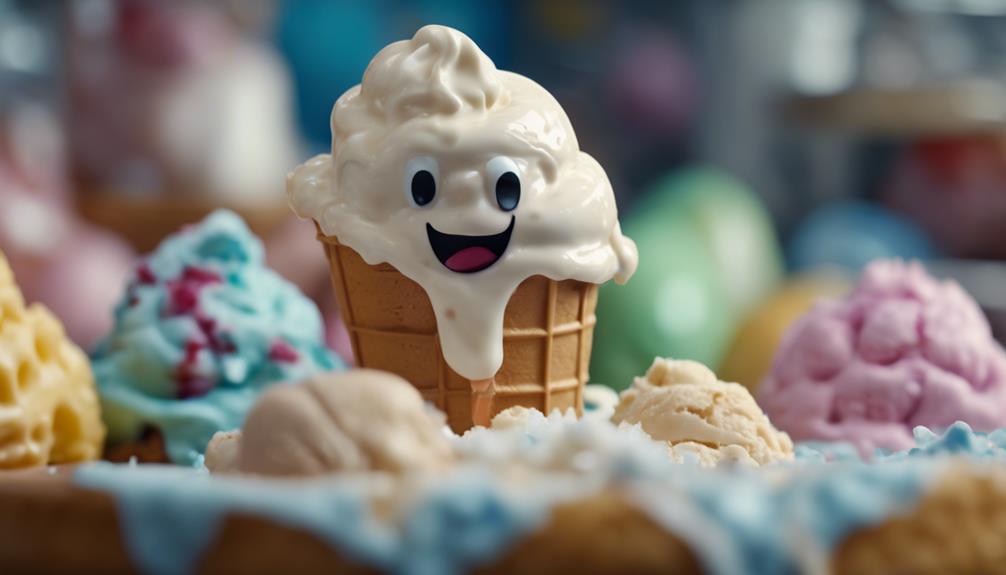Yes, ice cream can indeed go bad. Signs such as a sour taste, unusual odors, graininess, ice crystals, or bulging containers are indicators of spoilage. Freezer-burned ice cream is still safe to eat but may have a different taste and texture due to the presence of ice crystals. By storing it in airtight containers in the coldest part of the freezer, you can help preserve its freshness. Unique tips like cutting pint containers can make it easier to access. Proper freezer placement is crucial for maintaining quality. Explore additional methods to extend the shelf life and ensure the best quality of your ice cream.
Key Takeaways
- Sour taste, slimy texture, off odors, graininess, or ice crystals indicate spoiled ice cream.
- Freezer-burned ice cream is safe but may have altered taste and texture.
- Proper storage in airtight containers at below 0°F prevents bacterial growth.
- Shelf life varies with preservatives; homemade lasts about 3 months.
- Organize freezer for optimal air circulation and store ice cream in the coldest spot.
Freezing and Bacteria Growth
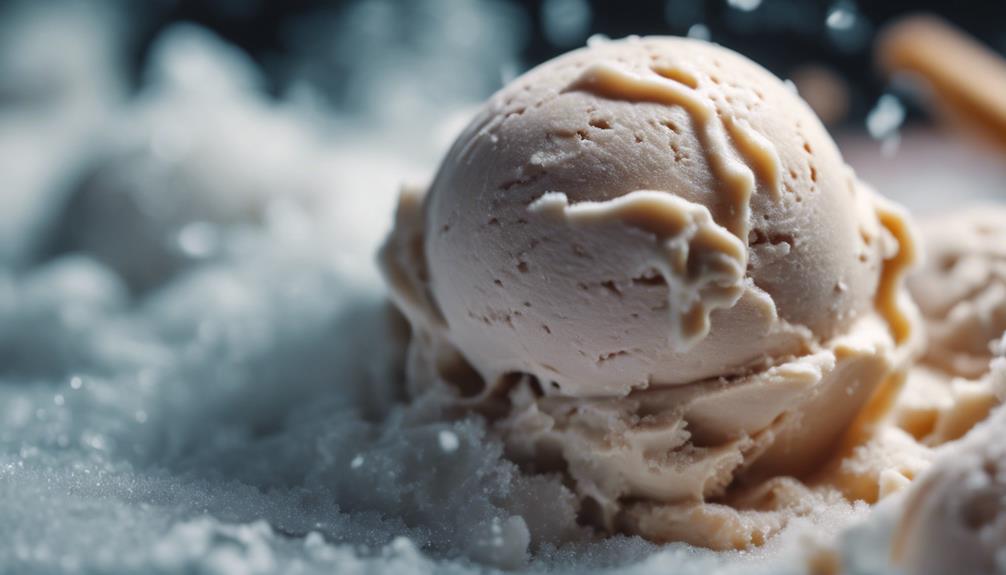
Freezing ice cream only slows down, rather than completely halts, the growth of bacteria. This is because ice cream contains dairy ingredients, providing an ideal environment for bacteria to thrive. To prevent spoilage, it's essential to maintain a consistent freezing temperature. Fluctuations in temperature during storage can lead to bacterial contamination, compromising the quality and safety of the ice cream. Properly stored ice cream can last longer by inhibiting bacterial growth.
When ice cream is exposed to temperatures above freezing, bacteria can still multiply, albeit at a slower rate compared to when stored at warmer temperatures. This means that even though freezing helps preserve ice cream, it doesn't eliminate the risk of bacterial growth entirely.
Signs of Spoiled Ice Cream
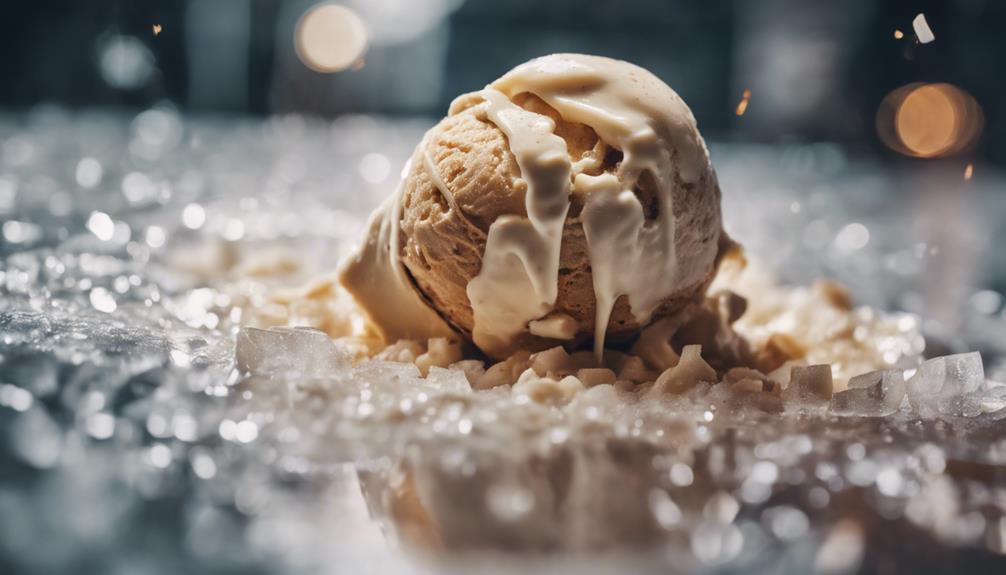
You need to know the signs of spoiled ice cream to avoid consuming unsafe products.
Look out for:
- Sour or slimy taste
- Off odors
- Graininess
- Ice crystals
Bulging or leaking containers, ice shards, and gummy textures are all indicators of potential spoilage.
Spoiled Ice Cream Indicators
Signs indicating that ice cream has spoiled include bulging or leaking containers and changes in texture like graininess or the presence of ice crystals.
Spoiled ice cream may also develop an off odor, tasting sour or slimy. These indicators are essential in determining whether the ice cream is safe to eat.
Texture changes, such as the formation of ice crystals or a gritty texture, are clear signs of spoilage.
If you notice any unusual changes in color, consistency, or taste, it's best to discard the ice cream to avoid consuming unsafe products.
Understanding these signs can help you avoid the risk of consuming spoiled ice cream, which could lead to foodborne illnesses.
Keep a close eye on your ice cream's appearance, smell, and texture to make sure you enjoy it at its best and avoid any potential health risks associated with consuming spoiled products.
Recognizing Spoilage Signs
To identify spoiled ice cream, pay attention to visible changes like bulging or leaking containers, which can indicate potential bacterial growth.
Texture changes are also key indicators of spoilage; if the ice cream appears grainy with ice crystals or has a dull color, it's likely not safe to eat.
Additionally, be wary of any off odors emanating from the ice cream, as a sour or slimy smell can signal that it has gone bad.
Consuming ice cream with these signs of spoilage can pose health risks due to potential bacterial growth, leading to illnesses. It's essential to recognize these signs of spoilage promptly to prevent any adverse health effects.
When in doubt about the quality of your ice cream, it's best to err on the side of caution and discard it to avoid any potential health issues associated with consuming spoiled ice cream.
Safety of Freezer-Burned Ice Cream
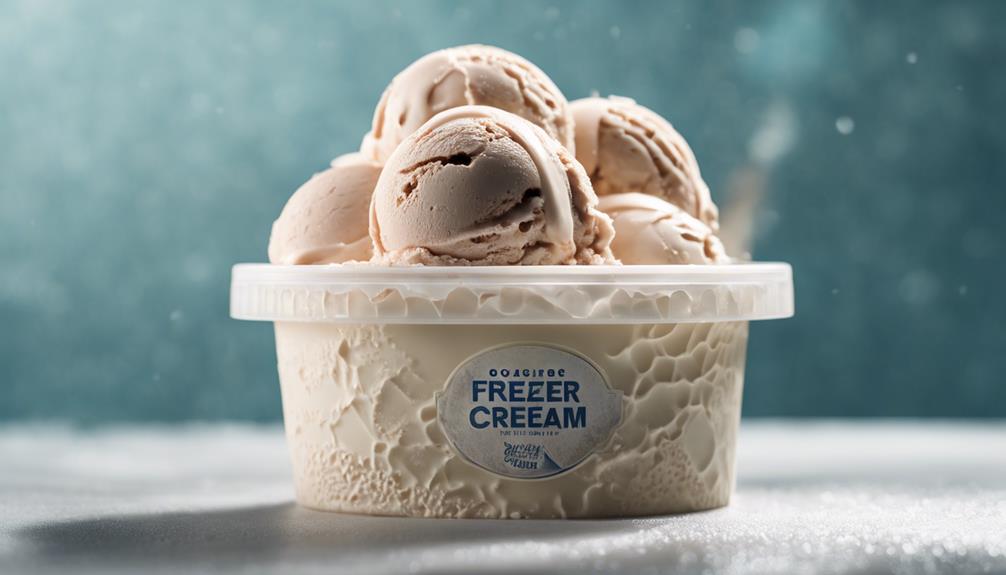
If you find freezer-burned ice cream in your freezer, don't worry – it's safe to eat. While the taste and texture may be affected by the ice crystals, you can still enjoy it by turning it into a delicious milkshake.
Freezer burn might make your ice cream a bit crunchy, but it won't harm you if stored correctly.
Freezer-Burned Ice Cream Safety
Freezer-burned ice cream remains safe for consumption, despite potential changes in taste and texture. When ice cream develops freezer burn, it may not look appetizing, but it's still safe to eat.
The crystallization of ice crystals on the surface of the ice cream causes the freezer burn. Although freezer-burned ice cream may not taste as creamy or flavorful as it did when first purchased, it doesn't mean the ice cream has gone bad.
Freezer burn affects the quality rather than the safety of the ice cream. To make the most of freezer-burned ice cream, consider turning it into delicious milkshakes or blending it with other ingredients to mask any undesirable changes in texture or taste.
Properly storing ice cream and being mindful of the shelf life can help minimize the chances of freezer burn and preserve the quality of the frozen treat.
Impact on Taste
When ice cream develops freezer burn, its taste and texture may be noticeably altered, though it remains safe for consumption. Freezer burn causes ice crystals to form on the surface of the ice cream, giving it a gritty texture. The presence of these crystals can make the ice cream taste stale and slightly crunchy.
While the flavor may not be as pleasant as fresh ice cream, eating freezer-burned ice cream is unlikely to make you sick. If you encounter freezer-burned ice cream, you can try scraping off the crystallized parts or blending the ice cream into a milkshake to improve its consistency.
Despite the changes in taste and texture, the ice cream is still safe to eat. So, if you find freezer-burned ice cream in your freezer, feel free to enjoy it with the knowledge that it may not be as delicious as before, but it won't harm you.
Texture Changes
Experiencing texture changes in ice cream due to freezer burn doesn't compromise its safety for consumption. When ice cream develops freezer burn, ice crystals form on its surface, leading to an altered texture that may feel stale and crunchy. Although this change in texture may not be as enjoyable as the original creamy consistency, freezer-burned ice cream is still safe to eat.
You can easily improve the texture by scraping off the ice crystals or blending the ice cream with a bit of milk to create a tasty milkshake.
While freezer burn affects the quality of ice cream, causing it to lose some of its appeal, it doesn't pose any health risks. Consuming freezer-burned ice cream may not result in illness, but it can impact the overall flavor of the treat.
To prevent texture changes and maintain the original smoothness of your ice cream, it's crucial to store it properly in the freezer and avoid temperature fluctuations.
Proper Ice Cream Storage

To maintain your ice cream stays fresh and delicious, proper storage is key. Store ice cream in an airtight container to shield it from air exposure and freezer burn. Place the container in the coldest part of the freezer, typically at the back, to preserve its texture and flavor.
Before sealing the container, consider using plastic wrap or wax paper directly on the ice cream's surface for an extra layer of protection. It's also essential to organize your freezer to encourage proper air circulation and even freezing, which helps prevent ice crystal formation in the ice cream.
Make sure your freezer is set below 0°F (-18°C) to extend the ice cream's freshness and quality. By following these storage tips, you can enjoy your favorite ice cream treats at their best for a longer period.
Innovative Storage Tips

For enhanced ice cream storage efficiency, consider implementing innovative techniques to maintain freshness and quality.
To keep your ice cream at its best, try cutting a paper pint to make slicing easier and reduce air exposure. Another trick is to press down on the ice cream's surface and cover it with plastic wrap before sealing to help maintain freshness. Storing ice cream upside down can also protect the surface from air exposure and potential freezer burn.
Look for purposeful packaging options like True Scoops offers, designed for convenient ice cream storage solutions. Additionally, new pint containers with ice cream mix inside are both freezable and food-safe, providing an easy way to store and dispose of leftover ice cream.
Longevity of Ice Cream

Ice cream can preserve its quality and freshness for an extended period when stored properly. Here are some key points to keep in mind for maximizing the longevity of your favorite frozen treat:
- Shelf Life of Ice Cream:
Ice cream from the grocery store, with added preservatives, can last up to a year in the freezer. On the other hand, homemade ice cream, without artificial stabilizers, typically lasts about 3 months. Be mindful of these variances when assessing your ice cream's shelf life.
- Growth of Bacteria:
Keeping your freezer temperature below 0°F is essential as it slows down bacteria growth, aiding in extending the freshness of your ice cream. This is particularly important for homemade varieties that may lack the preservatives found in commercial options.
- Store Your Ice Cream Carefully:
To maintain the creamy texture of your ice cream and prevent the formation of ice shards, make sure that your ice cream is sealed tightly in an airtight container before placing it in the freezer. Proper storage can have a notable impact on the overall quality and longevity of your frozen dessert.
Best Freezer Placement
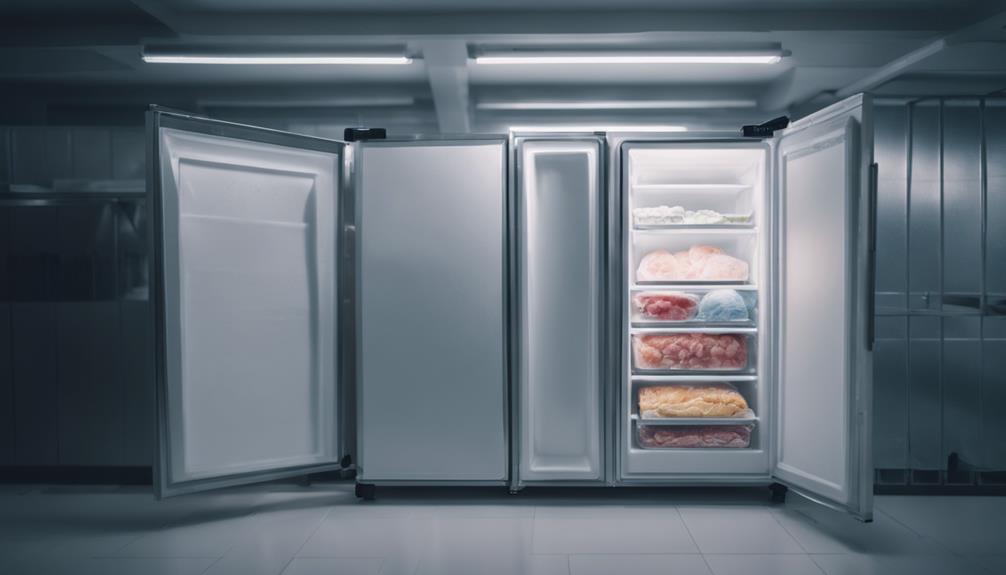
Maintaining the best freshness and texture of your ice cream starts with storing it in the coldest part of the freezer. Placing your ice cream in the coldest spot, typically at the back or bottom of the freezer, is essential to optimize freshness and maintain quality. This location helps preserve the texture of the ice cream for a longer shelf life by minimizing temperature fluctuations and exposure to warm air.
By keeping your ice cream away from the freezer door, you can prevent texture changes and ice crystal formation. Proper freezer placement not only safeguards the quality of your ice cream but also ensures uniform freezing, which is vital for texture preservation.
Organizing your freezer to allow for proper air circulation and consistent freezing temperatures will help keep your ice cream at its peak quality. Remember, where you store your ice cream can make a significant difference in how long it stays delicious.
Frequently Asked Questions
How to Know if an Ice Cream Is Bad?
To know if your ice cream is bad, look for signs like grainy texture, off odors, or ice crystals on the lid. Spoiled ice cream may have a dull color, sour taste, or bulging containers.
What Happens if You Have Bad Ice Cream?
If you have bad ice cream, digestive issues or foodborne illnesses can occur. It's essential to recognize signs like grainy texture or off odor. When in doubt, toss it to prevent health risks.
At What Point Does Ice Cream Go Bad?
Ice cream goes bad when signs like ice crystals, color changes, or a sour smell appear. Once opened, eat it within 1-2 months for best taste. Store properly below 0°F. Bacterial growth can spoil it.
How Do You Know if Ice Has Gone Bad?
When you open the container, trust your senses. If ice cream has gone bad, you'll notice large ice crystals, a grainy texture, or a dull color. Don't risk it – spoilage means it's time to toss it out.
What Are the Signs That Ice Cream Is Spoiled and Should Be Tossed Out?
When it comes to ice cream expiration date, there are some clear signs that it has gone bad. Look for any signs of crystallization, freezer burn, or strange odors. If the ice cream has become overly hard or has changed color, it’s time to toss it out and get a fresh tub.
Conclusion
Just like ice cream can go bad if not stored properly, relationships can also sour if not taken care of.
Remember to keep your freezer clean and organized, rotate your ice cream stock, and always check for signs of spoilage.
By taking care of your ice cream, you can enjoy it for longer and savor every sweet moment.
Just like with relationships, a little effort can go a long way in preserving the sweetness.
